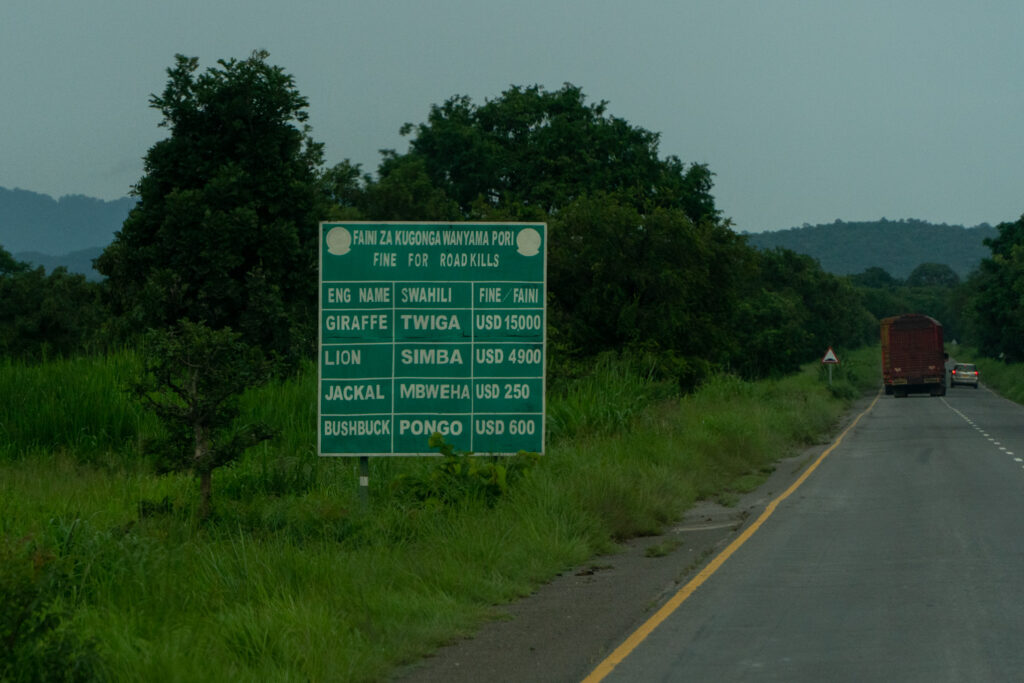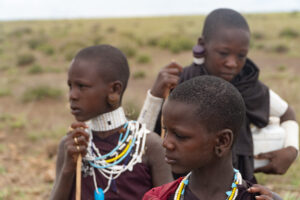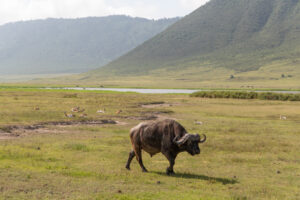“From 17th to 26th of February 2022”
Our border crossing
We arrived in Tanzania. As always, the border crossing was not easy. Few travellers enter African countries by land. The process is not always very smooth. Looking back, we were lucky enough to cross at the same time as a convoy of 3 over-equipped Land Rover Defenders, driven by South Africans used to cross borders. They are on an expedition to the North Cape in Norway. For them, the borders will become more complicated in South Sudan with an escort and in Egypt where the administration is extremely heavy to bring in a vehicle. Coming back to Tanzania, we have all the necessary photocopies: negative PCR tests, vehicle and identity papers, driver’s licence and email confirmation of the entry form online.
The first step on the Tanzanian side is about Covid. The person in charge of health checks meticulously the conformity of the test on a platform provided for this purpose and carries out a quick test to confirm the negative result. The rest of the process goes smoothly: issuance of the visa for $50 each, stamping of our carnet de passage, payment of the road taxes for the vehicle and contracting a car insurance. This last point took a little more time. To cut a long story short, we heard that there are a lot of scams at the border, or exaggerated rates. We were able to make sure (it’s the case to say it) that there were no problems with the main office of the National Insurance Corporation.
The day is coming to an end, we hit the road an hour before dark. The storm hits and we decide to stop at a petrol station for the evening. As we are tired and the rain continues outside, we go in search of food. For 2000 shillings (0,70€) in a small street restaurant, we find a small beef soup with a plantain. The grilled corn we bought just after finished to fill our stomachs.



It couldn’t be more typical for a first evening in Tanzania. The locals seem surprised to see us here. They are not used to tourists in this region. Very few of them speak English. Even to give us prices it’s complicated.
The Ngosi crater
There are many hikes on the road between the border and Dar es Salaam. But all of them are not free, at the high price of 10$ per person. So we won’t be able to do them all. We have spotted one that leads to the top of a crater, the second largest in Africa according to the signs. We take the small dirt road to the entrance of the reserve. With the rains of the previous days, large puddles have formed on the road. Since we lost our number plate when we crossed a water crossing in Mozambique, we are careful. It is better to stop as soon as possible to avoid getting stuck.
A little further on, we find a nice grassy area between the forest and a cornfield, perfect for camping. We are only one kilometre from the car park, ideal for starting the walk.



The path takes us through the jungle. As we go along, it narrows down to a small path in the middle of this luxuriant vegetation. I admit that I am not reassured. To begin with, the tsetse flies have been following us since we started walking. Attracted by the darkness, a dozen of them landed on my jumper and trousers. Tsetse flies can carry unpleasant diseases. Moreover, we have to be careful with snakes that could be mistaken for lianas. Vigilant, we move forward at a good pace until we come across a large group of school children. They are quite tired but happy to meet foreigners, some of them even asking us for pictures.



Once we reach the viewpoint. We discover the crater, and in its centre, the lake that has formed. The view is splendid! We are lucky that it is clear. In the distance, in the jungle, we hear the cries of monkeys and birds. The view is a reward for our climb.



On the way back, they confirm that we can stay on our spot for the night. It’s perfect! There are few passages, we will be quiet.
In Tanzania, especially in these less touristy regions, nobody speaks English. To make ourselves understood, we use a lot of gestures and learn a bit of Swahili: “Mambo = how are you, Poa/Safi = good, Unaenda wapi ? = where are you going ? Ninakwenda … = I am going to …, kutembelea = to visit …”.
Mbeya, south west of Tanzania
We arrive in Mbeya, the largest city in the South East region. Our routine of arriving in a new country starts. We start by finding a sim card to get internet access. Then we withdraw cash in a bank without any fees. In each country, the majority of banks charge withdrawal fees for international cards. So we go around the banks until we find the one we need.
We also take advantage of being in a big city to finally wash our car. Uyo hasn’t seen a jet of water since Mozambique at the end of last year. It is important to wash the chassis regularly. It rusts more easily with sand and mud. We choose a small car wash on the side of the road and we are not disappointed. They are real professionals, nothing to complain about. Uyo has never been so clean, we don’t recognize it anymore. Everything was cleaned from the chassis to the roof, including the interior and exterior windows. Even the tyres have been polished and have a black rubber like new.


On the road to Iringa – Nina kwenda Iringa
The road is still long to Dar es Salaam. We take our time to take breaks and visits in order to discover the regions. The landscapes we cross are beautiful. But the driving is difficult between the road which narrows, the many trucks and the buses which overtake at all costs.



Not so fast! We are stopped by the police in a small village who accuse us of speeding. 57km/h instead of 50km/h. We don’t believe it. We are warned twice about the speed controls on this road and our eyes are riveted on the speedometer. We deny it and ask for proof. Between the stories of corruption and photo montages, we have heard a lot about this road. We insist and ask to see the radar and the original photo, otherwise we won’t pay the fine. The proof is presented to us a little further up the road when a camouflaged policeman emerges from the bushes at the exit of a 50 zone. It’s time to apologise. We’ve been very careful but we didn’t know they were this disingenuous. All right, for the rest of the journey, we’ll drive at 40km/h instead of 50. We pay the 30000 Shillings (12€) fine against an official receipt. Without a receipt, i.e. in the pockets of the policemen, we are offered a discount. Corruption is never far away. Not very clean the policemen who were lecturing us, the purity of the white uniform doesn’t suit them so well after all…
At the end of a red dirt road, which leaves the main road, we find a perfect place to spend the night by a lake. We are almost alone. A fisherman comes to cast his net in the lake every morning, on a small wooden boat. He does this with flexibility, standing in this small, rickety boat. We like this quiet place in the middle of nature so much that we decide to stay there for a second night. This is also the opportunity to take the kayak out and move on to our video mountains.





Before reaching Iringa, the next big town, we stop at Isimila Stone Age natural pillars. In the hollow of the mountains a small canyon has formed creating natural towers. Like all natural areas in Tanzania, you have to pay. For foreigners it is 10$ per person plus 18% VAT. We have a tight budget and this amount is too much for a simple walk. We hesitate. Then, back at the reception, we ask if it is possible to have a reduction or to take turns to go on the tour with the same permit. But the reserve officer does his job well and cannot change the prices set by the government.
We finally decide to take only one permit to stay within our budget. We draw lots to decide who will go to see the red rock pillars. The one who guesses the time with the most accuracy will go. Valentin says 12:42, Laurène 12:46. Believe it or not, it was 12:44. We then flip a coin. Phew, the coin doesn’t fall on the edge! It’s Valentin who goes with the mission to take pictures and videos. The consolation prize for Laurène was a visit to the little museum next to the reception.





Iringa, the great market town
We finally arrive in Iringa. This small town in the south of Tanzania has been recommended to us by other travellers. It is surrounded by mountains and looks like a giant market. In front of each door, a small stall is set up to sell food, clothes, fabrics, wicker baskets and other objects of all kinds. The atmosphere is welcoming and you feel at ease right away.


We set up in the car park of Neema Craft. This is a non-profit organisation founded in 2011. It helps, trains, employs and supports people with disabilities. The association consists of a large creative workshop, a café, a hostel and a small shop. It’s a place we discovered on the iOverlander app, our favourite guide since the beginning of the trip. It’s a must-see meeting point for tourists, as we discover when we enter the café. It is filled with mostly white people.
We spend the night in the car park of the association, which has warmly invited us to stay. We want to visit the workshops the next day. It is Nashon who offers to show us around. A few years ago, they only produced postcards. Their catalogue has developed well since then. There are workshops for weaving, sewing, silk-screening and carpentry. Most of the materials are local, from wood from Morogoro to textile fibres from the Iringa region. The workers all have a job that suits their disability. The main mode of communication in this place is sign language as deaf-mutes make up 60% of the people employed here.






We take the road again after lunch as we know it is long and complicated. Heavy trucks make up 90% of the vehicles and on the mountain roads the traffic can be quite slow. Fortunately, unlike Malawi, few people walk on the roadside. The trucks are all decorated. You can read slogans like Mashaallah, Only God know or even phrases written in Swahili on the top of the windscreen or on the back, which we try to decipher with our translation application.



Mikumi, the road in the middle of a national park
After the winding mountain roads in the middle of trucks, we arrive in Mikumi. It is a small town mainly known for being located at the entrance of the national park of the same name. It extends over the whole region of 3230 km2.



The main road passes through the park. As the signs indicate, the speed limit is 50km/h to protect the wildlife. Other, more atypical signs list the animals and the price of fines if you hit one. A lion $4900, a giraffe $15000. It’s quite disorienting. Especially when the buses and trucks we had passed before overtake us at 80km/h, or more for some. For once, we don’t hesitate to drive slowly.
We take the opportunity to look for animals on both sides of the road. The first ones we see are the baboons on the road. Then on our left we start to see Masai giraffes. Their spots are different from the giraffes we saw in South Africa. On the right side we see small herds of zebras and behind them buffalos. After an hour’s drive, it’s already a nice overview, a preview of the park that we will visit later with Valentin’s parents.





At nightfall, we leave the park and find a quiet place, not far from the road, to sleep. Another nice wilderness campsite. Since we arrived in Tanzania, we have been finding wide open spaces in the middle of nature to settle down for a night or two. This is a luxury we did not have in Malawi where the places accessible by vehicle are all inhabited. The landscapes change as we travel to Dar Es Salaam and so our garden is different every morning.





One evening, just after our shower, two young men came up to us. They were in charge of the surveillance of a nearby construction site and were looking for company for the evening. They suggest a game of cards but we spend the hour talking. In the early morning, we meet them at their post. We share a last moment with them around a tea before leaving for Dar Es Salaam.



Dar es Salaam, our second capital since our departure
At the end of the week, we reach the capital of the country. We quickly feel the difference of climate. The sun warms the air of the Indian Ocean and the tarred and concreted city keeps the heat. The traffic is heavy. We start by doing multiple loads of laundry which takes longer than expected. We finally enter the centre of this big city at rush hour. On this Friday evening, beginning of the weekend, we spend 30min to make 1km in a busy street. The day starts to be long and tiring, the heat not helping. The tall buildings that soar into the sky are particularly striking. After several months in Africa, we are not used to seeing such infrastructures.
We found a small local hotel at a very competitive price with secure parking. This is an important point as we intend to leave our van there during our stay in Zanzibar. To reach it, we are not at the end of our troubles. First of all, the GPS leads us to the wrong destination. We arrive in the right street after 3km of extra traffic. Last obstacle, the road is blocked 20m before the entrance gate. Laurène continues on foot to check prices and parking. Everything is ok. She returns with the guard to guide us through the narrow streets to the back entrance.
This is the first time we have stayed in a hotel since we started travelling with Uyo. In Dar Es Salaam, the campsites are twice as expensive and far from the port of departure for Zanzibar. When we entered the room, what a nice surprise to discover the air conditioning. The place is clean with a small bathroom. We didn’t ask for so much. The only drawback is the busy bar just below the window. The sun is setting over the city’s rooftops and the music is already starting to play. If you have to live with the noise, you might as well join in the fun. Tomorrow we have a day of rest and shopping before embarking for Zanzibar on Sunday lunchtime.

The area is not touristy. At the bar, we meet only locals. We try to taste all the local beers and discover our favourites. All these beer mixtures surprise Beatus, our bar neighbour. Originally from the Kilimanjaro region, he grew up here and works in import-export of crops such as cashew nuts. At 31, he is a young father. He has just returned from a week with his family in Zanzibar. The relationship is good and he introduces us to his friend Isaac who joins him. He is a driver. He is proud to tell us that in his spare time he practices dancing and swimming.
The two friends take us into the back alleys of the neighbourhood to join a small party in honour of their friend’s wedding. The real celebration will be on Sunday, we will attend the pre-party. The atmosphere is great, a host with a microphone sets the rhythm for the evening. The women dance on a small square between the tin-roofed houses. The men spread out all around are watching. Small shops in the area sell beer. The festivities continue in the bar behind our hotel. Laurène is invited to dance with the women who shake their asses to the rhythm of the music. The pelvis is shaking all over the place and I have a hard time keeping up. I still need some practice. Tired, we don’t last long after midnight.


The next day, while our van stays in the hotel, we take an Uber to the ferry. On the road, we chat with our driver Anthony. Amazed by his perfect and elaborate English, we ask him about his life. He was an IT engineer in a Chinese bank. The branch in Dar Es Salaam closed down following the Covid crisis. Since then, it has been very difficult to find a job, even if he is qualified and experienced. We know that his profile is very much in demand in Europe. We are becoming more aware of the difficulties that people face in Africa.
That’s it, we arrive at the port. Valentin is happy at the idea of seeing his parents in a week. After 4 months on the road, he misses them. We are excited about this escapade in Zanzibar which sounds like a holiday.





Pingback: #12 Beautiful beaches, kite surfing and snorkelling on the island of Zanzibar